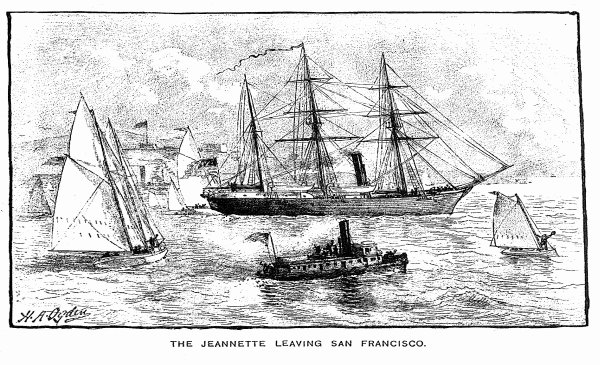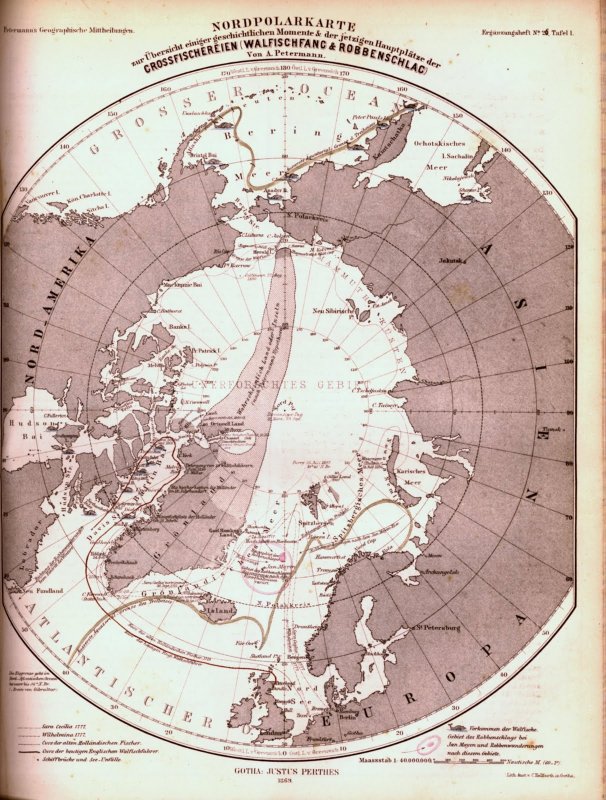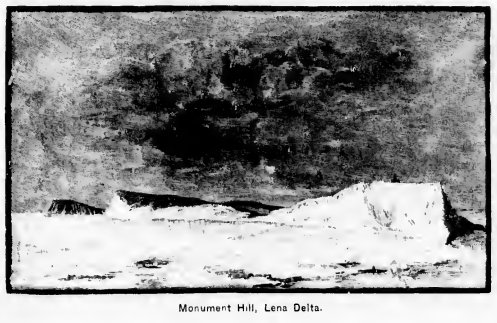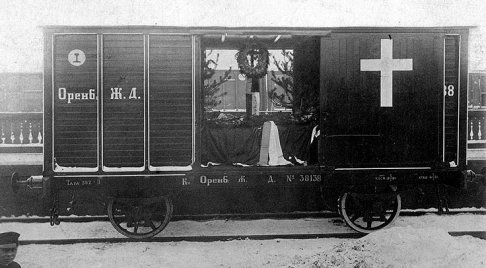or
The Astonishment of a Sailor on Finding Buckshot in His Portion of Tomatoes.
Hidden in the details of the Jeannette Expedition one finds a factor in common with the Franklin Expedition: lead poisoning.
The Jeannette Expedition
The USS Jeannette was formerly HMS Pandora. She was purchased from the Royal Navy by Allen Young, used for his Arctic voyages of 1875-1876 and then sold to James Gordon Bennett, Jr. in 1878. James Gordon Bennett, Jr., best known as Gordon Bennett, was the owner of the New York Herald. He was famous for having financed Stanley's search for Dr. Livingstone. The Pandora was renamed for Gordon Bennett's sister, Jeannette Bennett.

USS Jeannette leaving San Francisco escorted by small ships.
At the time when the Jeannette Expedition was being planned - 1878 - much of the Arctic was still unknown and uncharted. Maps produced by such widely respected cartographers as August Heinrich Petermann showed either blank areas or highly speculative land areas where no voyager had ever gone and returned to tell the tale. Much effort was expended and many brave lives lost in expeditions which added little by little to the Arctic maps of the heroic ages of Arctic discovery.

North Polar chart by Petermann, 1868
The Jeannette Expedition under George Washington DeLong was primarily a scientific geographical expedition. The Jeannette was intended to travel along the coast of the land or to cross the open water - if either one of these theoretical entities existed. In terms of the intended mission - a journey across the top of the world - the expedition was a failure. In terms of the many scientific and geographical discoveries, the expedition was a success. Quite apart from the science, the political goodwill engendered by tragedy should never be forgotten.
The Jeannette, like so many ships before and since, became trapped in the ice, was crushed and sank. The crew had sufficient time to take to the ice with three boats and provisions. After a long and arduous journey the party passed through the New Siberian Islands and eventually reached open water. At sea, the three boats were separated. One was never seen again. Another made land in the Lena Delta near a small settlement. De Long's boat landed at the northern tip of the Lena Delta far from any help. The men's frozen bodies were found by search parties some weeks later.

Russian map of various Arctic exploration routes - my annotations in green.
It has often been the case with Arctic exploration that the failures were either buried in the ice or in the history books. Never one to be satisfied with broad-brush history, and knowing the truth in the old adage that the devil is in the detail, I wondered what snippets of forgotten science might be found in the writings about De-Long's expedition. Which led me to try to solve three Arctic history mysteries:
where is Mat Vay?
who shot the tomatoes?
what was the source of the lead that affected Franklin's men?
Mat Vay, also written as Matvay or Matvei is a district near to where De Long's men made landfall. The bodies were initially placed in a cairn on a height in Mat Vay and a large cross erected over the cairn. That height was named Monument Hill by the burial party.

Monument Hill, about 300 feet above sea level and overlooking the landing site was chosen because the landing site was only 20 feet above sea level and might be prone to flooding. The bodies were later conveyed home with all due dignity, by land, by rail and then by sea. At every halt on the railway journey the fallen heroes were given full military honors by the host nations.

De-Long and most of his men were buried in Woodlawn Cemetary, N.Y., some of the men being buried elsewhere - presumably in private, family ceremonies.
The island where De-Long's party landed has long since been renamed. It is now called Ostrov Amerika-Kuba_Aryta, or America-Cuba-Aryta Island.
The Franklin Expedition
Much has been written about the fate of the lost Franklin Expedition. Exhumations of a few bodies in the 1980s found that lead poisoning was a contributing factor in the deaths of at least some of the lost explorers. Ever since then the question has been whether the source of the lead was more likely to be canned food or distilled water. Strong evidence from the records of the Jeannette Expedition suggests that lead from canned foods was almost certainly the cause. Polar records in general suggest that water can be ruled out.
Although the Erebus and Terror were equipped with water distillation apparatus, this would most frequently not be needed in the Canadian Archipelago. It has been the common practice of expeditions to obtain water from pools and streams. The common picture of the Arctic as a frozen waste is misleading: throughout the year there are many locations where fresh water is obtainable. Distilling apparatus of the type used by the Franklin Expedition consumes coal. The coal carried by the ships had to be conserved for propulsion, so every possible endeavor would have been made to obtain drinking water other than by burning coal.
The Jeannette carried a 'Baxter boiler'. It appears likely that the reference is to the boiler from one of the many variants of the Baxter portable engine. That design of boiler was very efficient and reliable for its day. Although the arrangement of the piping and condenser gave trouble, the gadget produced just enough water for the Jeannette's crew. However, every effort was made to conserve coal.
I consider it most likely that Franklin and Crozier, from the time of entering Lancaster Sound, would have been prudent enough to conserve fuel by bringing water on board at every opportunity. When trapped in the ice it was possible to make drinking water from snow or old ice by burning fat, blubber and animal wastes. Many of the officers and crew had prior polar exerience. It is difficult to imagine that none of them had the intelligence to hunt or fish.
An aside on polar bears
The liver of the polar bear is poisonous to both humans and dogs. At the time of the Franklin Expedition the matter of polar bear liver was still subject to debate. Elisha Kent Kane, writing of the 1853 Grinell Expedition, thought that the matter was a "vulgar prejudice".
I satisfied myself that it was a vulgar prejudice to regard the liver of the bear as poisonous. I ate of it freely myself and succeeded in making it a favourite dish with the mess. But I find to my cost that it may sometimes be more savoury than safe. The cub's liver was my supper last night, and today I have the symptoms of poison in full measure - vertigo, diarrhoea, and their concomitants.
Elisha Kent Kane, Arctic Explorations, Chapter XXIX, October 08 1853
Kane was lucky. Others have had entirely different experiences. The following report is of an episode just before Christmas 1907 during the Danmark Expedition of 1906-8.
My monthly twenty-four-hour observations were exhausting, but they also saved me once from being poisoned. After spending a whole day and night at the stations in the mountains or in the barrel at the top of the mast, I was pretty tired and usually slept for a solid twelve hours afterward. During one of those sleeping spells the rest of the camp enjoyed a great dinner of bear liver. I was rudely awakened from my sleep by the doctor asking how I felt. Since I felt nothing but sleepiness I told him I was all right and he ordered me to get up at once and help him. As I got out of my bunk I noticed his green face and the next moment he turned around and vomited. Every man in camp was sick from liver poisoning.
A hunting party had brought back a large amount of bear's liver and the cook had turned it into a delicious ragout We had never heard the old superstition that bear's liver is poisonous but in our case the superstition certainly proved true. I helped the doctor take care of the men and I was deeply impressed by Ins resistance and his will power. He was as sick as any of them but he carried on without interruption. Everyone recovered eventually but it took a surprisingly long time and the after effects were most unpleasant Some had their eyesight affected, all ran a high temperature, suffered from diarrhea and after a while their skin began peeling. I learned later that some people have eaten bear's liver without any ill effects while others have shared our experience. So it seems likely that only some livers are dangerous. Years later when I became a professional bear hunter, I discovered that the Eskimos never eat the liver. I also noticed that their dogs sometimes leave it alone and sometimes eat it with relish. Apparently their sense of smell or taste tells them which livers are poisonous.
Peter Freuchen, Vagrant Viking, Chapter VI
That incident occurred in November or December 1907. Vitamin A was discovered in 1917. By the 1930s it was very widely known amongst Arctic explorers that eating polar bear liver is exceedingly dangerous to the health. It is now known that polar bear liver contains large stores of vitamin A. Hypervitaminosis A, especially in combination with other factors such as scurvy or tuberculosis can be fatal. It is entirely possible that at least some members of the Franklin Expedition died from illnesses made more acute from this contributary factor.
Canned food
From the invention of canning until the beginning of the 20th century, cans were sealed with lead solder. During all that time there was no agency responsible for food standards. It was a time when people began to rely on the good reputations of some canned food producers to avoid the unscrupulous practices of the 'fly-by-nights'. In the early days of canning, some producers would use more juice - or even water - than fruit, or use unripe fruit, or in some other way cheat the customer.
Widespread cheating got reported in the newspapers. Through advertising, honest producers promoted their 'brand'. For bulk purchasers such as the military, the brand name was all they could rely on. Formal scientific procedures of quality control, quality assurance and random sampling were yet to be invented.
It was widely known that the whole point of canning was to keep food from spoiling. Canned food remained safe to eat because the canning process removed the commonly known causes of food poisoning. It was not yet commonly known that badly soldered cans could be a source of lead poisoning. Even today, the most common idea about soldered cans is that the lead from the solder is in some way leached into the contents. It is not widely known that when a can is badly soldered, solder can enter the can and mingle with the contents.
When two surfaces are joined together closely, as in the assembly of ordinary copper piping, molten solder will be drawn into the joint by capillary action. If the join is not properly made or if too much solder, flux or heat is applied, solder can pass right through the join and can form droplets inside the tube. Sheet iron or steel requires more skill to solder, especially when the parts to be joined are hand-formed. In the early development of canning, when the can was sealed with solder, it is highly likely that the contents would have been contaminated to some degree with lead and / or flux.
In an age when canning was a new technology, it is exceedingly unlikely that any ordinary consumer would have eaten so much canned food as to show any symptoms of lead poisoning. In my researches I have found only one reported case which might possibly be attributed to lead poisoning. The news item is repeated below in its entirety.
A clergyman and his wife in Portland, Me., have recently suffered greatly from poisoning, caused by eating canned tomatoes.
New York Times, March 11 1871
Although the ordinary consumer would, at the time, most probably not dine daily on canned foodstuffs, the same could not be said of the Arctic explorer. From a record of the Jeannette Expedition:
At length, an epidemic seemed to break out among the whole company. Dr. Ambler was diligent in his search for the cause. There were no evidences of scurvy save in Alexia's case, and his was extremely doubtful. Finally the patients showed symptoms of lead poisoning, and the question at once arose, whence came the lead ? A few grains of shot found in the bodies of birds (guillemots) served for dinner one day sufficed to direct the conversation to the subject that was uppermost in the minds of all ; and at the same time, some one chancing upon several pellets of solder in the canned tomatoes, it was jocularly asked, " Who shot the tomatoes ? " which resulted in bringing to light the raison d'etre of the poisoning. Knowing how deadly wine might become by the dissolution of a single grain of shot left in the bottle from its cleansing, it was easy to understand how the acid fruits and vegetables had absorbed their noxious properties from the many drops of solder, composed of equal parts of lead and tin. And this cumulative poisoning had been in progress for months! Nor, as investigation proved, were these pellets the only source of the malady. Aware of the manufacturer's practice of covering certain qualities of sheet tin with solder, the cans were inspected, and many found to be coated with black oxide of lead. Scraping this off and analyzing it, Dr. Ambler became altogether satisfied as to the origin of the " epidemic."Note especially: "Aware of the manufacturer's practice of covering certain qualities of sheet tin with solder...". Sheet steel for the manufacture of cans is supposed to be plated with tin. 'Tinning', the process of flow-coating with solder, gives much the same appearance but can be deadly: ordinary solder is a mixture of tin and lead.
In The Lena Delta, George W Melville, 1884
During the period of interest, apart from guns, lead shot was used in the cleaning of bottles and jars. It was the duty of every cook to ensure that no shot was left in game prior to cooking. Hunting parties, expeditions and even ordinary farmers of that era would be unsurprised to find the occasional shot in a piece of meat. It was treated as something akin to grit: a harmless nuisance. The vast majority of people at that time would consider a person overly fastidious if they refused to eat food in which lead shot had been found. Small wonder, then, that the matter of lead in food was only raised on the Jeannette after much contaminated food had already been consumed.
Conclusions
For the reasons given I consider it highly unlikely that the distillation of water for drinking was a significant factor in the Franklin Expedition members' ingestion of lead.
Given:
1 - the relative novelty - at the time - of canned foods;
2 - the apparent safety of canned foods deduced from ordinary domestic consumption;
3 - the messing arrangements on most ships in which ordinary seamen would prepare food;
4 - the lack of general knowledge at the time of the dangers of using lead solder in the canning process,
it is very likely - in the relevant era - that:
the presence of lead in food would not have been suspected by any sailor or officer, perhaps even including the ships' doctors and other men of science.
Further / related reading:
History, Science And The TMT Boundary
http://www.history.navy.mil/library/online/jeanette.htm





Comments